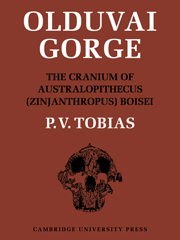Book contents
- Frontmatter
- Contents
- List of text-figures
- List of plates
- List of tables
- Introductory Note
- Foreword
- Editor's Note
- Acknowledgements
- I Introduction
- II Preservation and reconstruction of the cranium
- III The cranial vault
- IV The basis cranii externa
- V Certain critical angles and indices of the cranium
- VI The interior of the calvaria
- VII The thickness of the cranial bones
- VIII The endocranial cast of Zinjanthropus
- IX Metrical characters of the calvaria as a whole
- X The structure of the face
- XI The pneumatisation of the Zinjanthropus cranium
- XII The dental arcade and the palate
- XIII The pattern of dental attrition and occlusion, with comments on enamel hypoplasia
- XIV The size of individual teeth, absolute and relative
- XV The size of the dentition as a whole
- XVI The crown shape index of the teeth
- XVII The morphology of the teeth
- XVIII Summary of cranial and dental features of Zinjanthropus
- XIX The taxonomic status of Zinjanthropus and of the australopithecines in general
- XX The cultural and phylogenetic status of Australopithecus boisei and of the australopithecines in general
- References
- Index of persons
- Index of subjects
- Plate section
Foreword
Published online by Cambridge University Press: 05 November 2011
- Frontmatter
- Contents
- List of text-figures
- List of plates
- List of tables
- Introductory Note
- Foreword
- Editor's Note
- Acknowledgements
- I Introduction
- II Preservation and reconstruction of the cranium
- III The cranial vault
- IV The basis cranii externa
- V Certain critical angles and indices of the cranium
- VI The interior of the calvaria
- VII The thickness of the cranial bones
- VIII The endocranial cast of Zinjanthropus
- IX Metrical characters of the calvaria as a whole
- X The structure of the face
- XI The pneumatisation of the Zinjanthropus cranium
- XII The dental arcade and the palate
- XIII The pattern of dental attrition and occlusion, with comments on enamel hypoplasia
- XIV The size of individual teeth, absolute and relative
- XV The size of the dentition as a whole
- XVI The crown shape index of the teeth
- XVII The morphology of the teeth
- XVIII Summary of cranial and dental features of Zinjanthropus
- XIX The taxonomic status of Zinjanthropus and of the australopithecines in general
- XX The cultural and phylogenetic status of Australopithecus boisei and of the australopithecines in general
- References
- Index of persons
- Index of subjects
- Plate section
Summary
The discovery by Dr and Mrs Leakey of an australopithecine skull in Bed I of the deposits of the Olduvai Gorge is of major importance for two reasons. First, the skull was found at a stratigraphical level that has been dated with reasonable assurance by the potassium-argon method to well over a million years, indeed probably as much as one and three-quarters of a million. Second, the skull, though fragmented, was found to be practically complete except for the lower jaw; it was possible to piece together the broken fragments with fair accuracy and to demonstrate that it was almost free of distortion and deformation in spite of its prolonged period of fossilisation. In fact, apart from one specimen discovered by the late Dr Robert Broom at Sterkfontein in South Africa in 1947, no australopithecine skull is yet known that approaches in completeness the Olduvai skull.
It is particularly fortunate that the responsibility for the detailed study of this skull should have been given to Professor P. V. Tobias, for he has had many years of experience in dealing with fossil hominid material as well as a wide acquaintance with the skeletal structures of the higher Primates and their degree of variability. I do not suppose that any such meticulous and exhaustive description of a fossil hominid skull as is to be found in this monograph has ever before been made, even if account is taken of Boule's description of the Chapelle-aux-Saints skull, or of Weidenreich's account of the crania of Chinese representatives of Homo erectus.
- Type
- Chapter
- Information
- Olduvai Gorge , pp. xv - xviPublisher: Cambridge University PressPrint publication year: 1967



